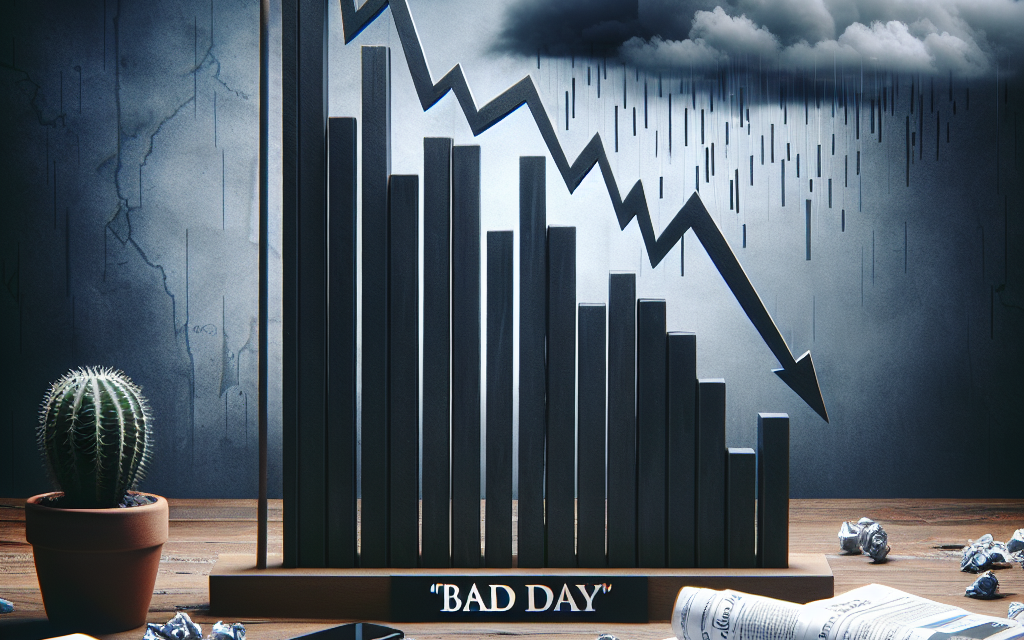“S&P 500 Plummets: Echoes of the ‘Post-Fed Tantrum’ Resurface in Market Turmoil.”
Introduction
On a day marked by heightened volatility, the S&P 500 experienced its most significant decline since the aftermath of the ‘Post-Fed Tantrum,’ reflecting investor concerns over economic uncertainty and interest rate fluctuations. The market’s downturn was driven by a combination of disappointing economic data, rising inflation fears, and a reassessment of the Federal Reserve’s monetary policy stance. As traders reacted to these developments, the index saw a sharp sell-off, underscoring the fragility of market sentiment in the current economic landscape.
S&P 500’s Historical Context: The ‘Post-Fed Tantrum’ Comparison
The S&P 500 recently experienced a significant downturn, marking its worst day since the infamous ‘Post-Fed Tantrum’ of 2013. To understand the implications of this decline, it is essential to delve into the historical context surrounding the ‘Post-Fed Tantrum’ and how it relates to current market dynamics. The term ‘Post-Fed Tantrum’ refers to the market’s reaction following the Federal Reserve’s announcement in May 2013 regarding the potential tapering of its quantitative easing program. This announcement caught investors off guard, leading to a sharp sell-off in equities as market participants recalibrated their expectations for interest rates and economic growth.
During that period, the S&P 500 experienced a rapid decline, reflecting a broader sentiment of uncertainty and fear among investors. The abrupt shift in monetary policy expectations triggered a wave of volatility, as traders grappled with the implications of reduced liquidity in the market. This historical episode serves as a poignant reminder of how sensitive financial markets can be to changes in central bank policies. Fast forward to the present day, and we find ourselves in a similar environment, where the S&P 500 is once again reacting sharply to shifts in monetary policy and economic indicators.
The recent decline in the S&P 500 can be attributed to a confluence of factors, including rising inflation concerns, interest rate hikes, and geopolitical tensions. As the Federal Reserve continues to navigate the delicate balance between fostering economic growth and controlling inflation, investors are left to ponder the potential ramifications of these decisions. The parallels between the current market environment and the ‘Post-Fed Tantrum’ are striking, as both scenarios highlight the fragility of investor sentiment in the face of changing monetary policy.
Moreover, the historical context of the ‘Post-Fed Tantrum’ underscores the importance of understanding market psychology. During times of uncertainty, investors often react impulsively, leading to exaggerated market movements. This phenomenon was evident in 2013, as well as in the recent sell-off, where fear and uncertainty drove traders to liquidate positions rapidly. As a result, the S&P 500’s decline serves as a reminder of the inherent volatility present in equity markets, particularly when influenced by central bank actions.
In addition to the immediate market reactions, the ‘Post-Fed Tantrum’ also had lasting effects on investor behavior and market dynamics. Following the initial shock, markets gradually stabilized as investors adjusted to the new normal of higher interest rates and a more cautious Federal Reserve. This adjustment period highlighted the resilience of the S&P 500, as it eventually rebounded and reached new highs. The current market may similarly experience a period of adjustment, as investors reassess their strategies in light of evolving economic conditions.
In conclusion, the S&P 500’s recent downturn serves as a stark reminder of the historical precedents set by events like the ‘Post-Fed Tantrum.’ As investors navigate the complexities of the current market landscape, understanding the lessons from the past can provide valuable insights into potential future movements. The interplay between monetary policy, investor sentiment, and market volatility remains a critical area of focus, as the S&P 500 continues to reflect the broader economic narrative. Ultimately, the historical context of the ‘Post-Fed Tantrum’ not only informs our understanding of the present but also shapes our expectations for the future trajectory of the market.
Key Factors Behind the S&P 500’s Decline
The recent decline of the S&P 500 has drawn significant attention, marking its worst day since the infamous “post-Fed tantrum” of 2013. This downturn can be attributed to a confluence of factors that have rattled investor confidence and led to widespread sell-offs across various sectors. One of the primary catalysts for this decline is the persistent concern surrounding inflation and the Federal Reserve’s monetary policy response. As inflation rates remain elevated, market participants are increasingly apprehensive about the potential for more aggressive interest rate hikes. This uncertainty has created a ripple effect, prompting investors to reassess their positions and risk exposure.
Moreover, the economic landscape has been further complicated by mixed signals from key economic indicators. While some reports suggest resilience in consumer spending and employment, others indicate a slowdown in manufacturing and a potential cooling of the housing market. This divergence has left investors grappling with conflicting narratives, ultimately leading to a more cautious approach. As a result, many have opted to liquidate positions in anticipation of a more challenging economic environment, contributing to the S&P 500’s sharp decline.
In addition to macroeconomic concerns, geopolitical tensions have also played a significant role in shaping market sentiment. Ongoing conflicts and uncertainties in various regions have heightened fears of supply chain disruptions and increased volatility in commodity prices. These factors have not only affected investor sentiment but have also raised questions about the sustainability of corporate earnings growth. As companies face rising costs and potential disruptions, analysts have begun to revise their earnings forecasts downward, further exacerbating the market’s decline.
Furthermore, the technology sector, which has been a significant driver of the S&P 500’s gains in recent years, has faced particular scrutiny. As interest rates rise, the present value of future cash flows for growth-oriented companies diminishes, leading to a reevaluation of tech stocks that have previously enjoyed lofty valuations. This sector’s pullback has had a disproportionate impact on the overall index, as many of the largest companies by market capitalization are technology firms. Consequently, the decline in tech stocks has not only contributed to the S&P 500’s downturn but has also raised concerns about the broader market’s health.
Investor sentiment has also been influenced by the behavior of institutional investors, who have been increasingly cautious in their trading strategies. With heightened volatility and uncertainty, many institutions have opted to adopt a more defensive posture, reallocating assets toward safer investments such as bonds or dividend-paying stocks. This shift in strategy has further fueled the downward momentum in the S&P 500, as selling pressure mounts and liquidity in the market tightens.
In conclusion, the S&P 500’s recent decline can be attributed to a complex interplay of factors, including inflation concerns, mixed economic signals, geopolitical tensions, and sector-specific challenges. As investors navigate this turbulent landscape, the focus will likely remain on the Federal Reserve’s policy decisions and their implications for economic growth. The market’s ability to stabilize will depend on how these key factors evolve in the coming weeks and months, as investors seek clarity amid uncertainty. Ultimately, the current environment serves as a reminder of the inherent volatility in financial markets and the importance of a well-considered investment strategy.
Investor Sentiment: Reactions to the Market’s Worst Day
On a day marked by significant volatility, investor sentiment took a sharp downturn as the S&P 500 experienced its worst performance since the infamous “post-Fed tantrum” of 2013. This sudden shift in market dynamics has left many investors grappling with uncertainty and reevaluating their strategies in light of the prevailing economic conditions. The sell-off was triggered by a confluence of factors, including rising interest rates, persistent inflationary pressures, and concerns over corporate earnings, all of which contributed to a pervasive sense of unease among market participants.
As the trading day unfolded, the S&P 500 plummeted, reflecting a broader trend of risk aversion that swept across various sectors. Investors, already on edge due to the Federal Reserve’s recent monetary policy decisions, reacted swiftly to the news, leading to a wave of selling that exacerbated the market’s decline. This reaction was not merely a knee-jerk response; rather, it was indicative of a deeper anxiety regarding the sustainability of economic growth in an environment characterized by tightening monetary policy. Consequently, many investors began to question the resilience of the equity markets, prompting a reevaluation of their portfolios.
In the wake of this downturn, analysts noted a marked shift in investor behavior. Many turned to safe-haven assets, such as government bonds and gold, as they sought to mitigate risk in an increasingly volatile market. This flight to safety underscores a growing belief that the current economic landscape may be fraught with challenges, leading to a more cautious approach among investors. Furthermore, the heightened volatility has prompted some market participants to adopt a more defensive posture, favoring sectors that are traditionally viewed as more resilient during economic downturns, such as utilities and consumer staples.
Moreover, the psychological impact of such a significant market decline cannot be understated. Investor confidence, which had been bolstered by a prolonged bull market, has been shaken, leading to a reevaluation of risk tolerance. Many investors are now more acutely aware of the potential for rapid market shifts, which has resulted in a more conservative investment approach. This shift in sentiment is further compounded by the media’s coverage of the market’s decline, which often amplifies fears and concerns, creating a feedback loop that can exacerbate volatility.
As the dust settles from this tumultuous trading day, it is essential for investors to reflect on their long-term strategies. While short-term fluctuations can be disconcerting, history has shown that markets tend to recover over time. Therefore, maintaining a focus on fundamental analysis and long-term goals may provide a more stable path forward. Nevertheless, the current environment necessitates a careful assessment of risk exposure and a willingness to adapt to changing market conditions.
In conclusion, the S&P 500’s worst day since the post-Fed tantrum has elicited a profound shift in investor sentiment, characterized by increased caution and a flight to safety. As market participants navigate this challenging landscape, it is crucial to remain vigilant and informed, recognizing that while volatility may be unsettling, it also presents opportunities for those willing to engage with the market thoughtfully. Ultimately, the ability to adapt to evolving circumstances will be paramount in weathering the storm and positioning for future growth.
Sector Performance: Which Areas Were Most Affected?
The recent performance of the S&P 500 has drawn significant attention, particularly as it faced its worst day since the infamous “post-Fed tantrum.” This downturn has not only impacted the index as a whole but has also revealed stark disparities in sector performance, highlighting which areas of the market were most affected by the prevailing economic conditions. As investors sift through the implications of this market movement, it becomes essential to analyze the sectors that bore the brunt of the decline.
To begin with, the technology sector, often viewed as a bellwether for market sentiment, experienced a pronounced downturn. This sector, which has been a primary driver of growth in recent years, saw substantial sell-offs as investors reacted to rising interest rates and inflationary pressures. The anticipation of tighter monetary policy has led to concerns about future earnings growth, particularly for high-growth tech companies that rely heavily on borrowing to fund their expansion. Consequently, major players in this sector faced significant losses, contributing to the overall decline of the S&P 500.
In addition to technology, the consumer discretionary sector also felt the impact of the market’s turbulence. As consumer sentiment wavers in response to economic uncertainty, discretionary spending tends to decline. This sector, which includes retail, automotive, and entertainment companies, is particularly sensitive to shifts in consumer confidence. The recent market volatility has prompted many investors to reassess their positions in this sector, leading to a sell-off that further exacerbated the overall market decline. As a result, companies within this space have seen their stock prices plummet, reflecting the broader concerns about consumer behavior in an uncertain economic landscape.
Moreover, the financial sector was not immune to the adverse effects of the market’s downturn. With rising interest rates often seen as a double-edged sword, banks and financial institutions typically benefit from higher rates through improved net interest margins. However, the current environment has raised fears of a potential economic slowdown, which could lead to increased loan defaults and a tightening of credit conditions. Consequently, financial stocks experienced significant pressure, as investors weighed the potential risks against the backdrop of a shifting economic landscape.
Conversely, some sectors demonstrated relative resilience amid the broader market turmoil. The utilities and consumer staples sectors, for instance, often serve as safe havens during periods of volatility. These sectors tend to provide essential goods and services, making them less sensitive to economic fluctuations. As investors sought refuge from the market’s turbulence, they gravitated towards these defensive sectors, which helped to cushion their overall losses. This flight to safety underscores the importance of diversification in investment strategies, particularly during uncertain times.
In summary, the recent downturn in the S&P 500 has illuminated the varying degrees of impact across different sectors. While technology, consumer discretionary, and financial sectors faced significant challenges, defensive sectors like utilities and consumer staples provided a counterbalance to the broader market decline. As investors navigate this complex landscape, understanding the nuances of sector performance will be crucial in making informed decisions moving forward. The current market dynamics serve as a reminder of the interconnectedness of economic factors and investor sentiment, emphasizing the need for vigilance in an ever-evolving financial environment.
Future Outlook: What This Means for the S&P 500
The recent downturn in the S&P 500, marking its worst day since the infamous ‘post-Fed tantrum,’ has raised significant concerns among investors and analysts alike. This sharp decline, characterized by heightened volatility and widespread sell-offs, prompts a closer examination of the future outlook for the index. As market participants grapple with the implications of this downturn, it is essential to consider the underlying factors that contributed to this situation and how they may shape the trajectory of the S&P 500 moving forward.
To begin with, the recent market turbulence can be attributed to a confluence of economic indicators and geopolitical tensions that have unsettled investor confidence. Rising inflation rates, coupled with the Federal Reserve’s ongoing monetary policy adjustments, have created an environment of uncertainty. As the Fed continues to signal its commitment to combating inflation, the prospect of further interest rate hikes looms large. This potential tightening of monetary policy could lead to increased borrowing costs for businesses and consumers alike, thereby dampening economic growth and corporate earnings. Consequently, investors are left to ponder how these factors will influence the S&P 500’s performance in the coming months.
Moreover, the current geopolitical landscape adds another layer of complexity to the market outlook. Ongoing conflicts and trade tensions can disrupt supply chains and create additional inflationary pressures, further complicating the economic recovery. As companies navigate these challenges, their ability to maintain profitability will be scrutinized, and any signs of weakness could trigger further sell-offs in the index. Therefore, it is crucial for investors to remain vigilant and assess how these external factors may impact the broader market.
In light of these challenges, some analysts suggest that the S&P 500 may experience a period of consolidation as it seeks to find a new equilibrium. This phase could involve fluctuations as investors reassess their positions and adjust their expectations based on evolving economic conditions. While this may create short-term volatility, it could also present opportunities for discerning investors to identify undervalued stocks within the index. As the market recalibrates, sectors that demonstrate resilience in the face of adversity may emerge as attractive investment options.
Furthermore, it is essential to consider the potential for a rebound in the S&P 500, particularly if inflationary pressures begin to ease or if the Fed signals a more dovish stance. A stabilization of economic indicators could restore investor confidence and lead to renewed buying activity. In this scenario, the index could regain its footing and embark on a recovery trajectory, driven by strong corporate earnings and positive economic data. However, this optimistic outlook hinges on the ability of policymakers to navigate the delicate balance between controlling inflation and fostering economic growth.
In conclusion, the recent decline in the S&P 500 serves as a stark reminder of the complexities inherent in the financial markets. As investors look ahead, they must remain cognizant of the multifaceted challenges that lie ahead, including inflation, interest rates, and geopolitical tensions. While the path forward may be fraught with uncertainty, it also presents opportunities for those willing to engage with the market’s dynamics. Ultimately, the future of the S&P 500 will depend on a myriad of factors, and a careful analysis of these elements will be crucial for navigating the evolving landscape.
Strategies for Investors During Market Volatility
In the wake of significant market fluctuations, particularly following the S&P 500’s recent downturn, investors are compelled to reassess their strategies in the face of volatility. The recent decline, reminiscent of the post-Fed tantrum era, underscores the importance of a well-structured approach to navigating turbulent financial waters. As market conditions shift unpredictably, it becomes essential for investors to adopt strategies that not only mitigate risk but also position them for potential opportunities.
One of the foremost strategies during periods of volatility is diversification. By spreading investments across various asset classes, sectors, and geographic regions, investors can reduce the impact of a downturn in any single area. This approach not only helps in cushioning against losses but also allows for exposure to different growth opportunities. For instance, while equities may be experiencing a downturn, bonds or commodities might perform better, thus balancing the overall portfolio performance. Consequently, a diversified portfolio can serve as a buffer against the inherent risks associated with market fluctuations.
In addition to diversification, maintaining a long-term perspective is crucial. Market volatility can often lead to emotional decision-making, prompting investors to react hastily to short-term market movements. However, history has shown that markets tend to recover over time. By focusing on long-term goals and resisting the urge to make impulsive changes based on daily market fluctuations, investors can better position themselves for future growth. This long-term mindset encourages patience and discipline, which are vital traits for successful investing.
Moreover, employing a systematic investment approach, such as dollar-cost averaging, can be particularly effective during volatile periods. This strategy involves investing a fixed amount of money at regular intervals, regardless of market conditions. By doing so, investors can take advantage of lower prices during downturns, effectively lowering their average cost per share over time. This method not only reduces the emotional stress associated with trying to time the market but also fosters a consistent investment habit that can yield positive results in the long run.
Furthermore, it is essential for investors to stay informed and conduct thorough research. Understanding the underlying factors driving market volatility can provide valuable insights into potential risks and opportunities. By keeping abreast of economic indicators, corporate earnings reports, and geopolitical developments, investors can make more informed decisions. This knowledge empowers them to adjust their strategies proactively rather than reactively, allowing for a more strategic approach to navigating market fluctuations.
Lastly, considering the role of cash reserves can be advantageous during periods of uncertainty. Maintaining a portion of the portfolio in cash or cash-equivalents provides flexibility and the ability to capitalize on attractive investment opportunities that may arise during market downturns. This liquidity can serve as a safety net, allowing investors to weather short-term volatility while positioning themselves for long-term gains.
In conclusion, while the S&P 500’s recent performance may evoke concern among investors, it also presents an opportunity to refine investment strategies. By embracing diversification, maintaining a long-term perspective, employing systematic investment techniques, staying informed, and considering cash reserves, investors can navigate market volatility with greater confidence. Ultimately, a disciplined and informed approach can help investors not only endure challenging market conditions but also emerge stronger and more resilient in their investment journeys.
Lessons Learned from the S&P 500’s Worst Day
The recent plunge of the S&P 500, marking its worst day since the infamous “post-Fed tantrum,” serves as a stark reminder of the volatility inherent in financial markets. This significant downturn, characterized by a sharp decline in stock prices, has prompted investors and analysts alike to reflect on the lessons that can be gleaned from such an event. Understanding the factors that contributed to this market reaction is crucial for navigating future uncertainties.
Firstly, the importance of economic indicators cannot be overstated. The S&P 500’s decline was precipitated by a series of economic reports that suggested a slowdown in growth, coupled with rising inflationary pressures. These indicators often serve as barometers for investor sentiment, and when they signal potential economic distress, market participants tend to react swiftly. This reaction underscores the necessity for investors to remain vigilant and informed about macroeconomic trends, as they can significantly influence market dynamics.
Moreover, the role of central bank policies in shaping market behavior is another critical lesson. The Federal Reserve’s decisions regarding interest rates and monetary policy have far-reaching implications for equity markets. In this instance, the market’s negative response can be attributed to concerns over the Fed’s potential tightening measures in response to inflation. Investors must recognize that central bank actions can create ripples throughout the financial landscape, and understanding these policies is essential for making informed investment decisions.
In addition to macroeconomic factors, investor psychology plays a pivotal role in market movements. The S&P 500’s sharp decline illustrates how fear and uncertainty can lead to herd behavior, where investors collectively sell off assets in response to perceived risks. This phenomenon highlights the importance of maintaining a long-term perspective and avoiding impulsive decisions driven by short-term market fluctuations. By cultivating a disciplined investment strategy, individuals can better withstand the emotional turbulence that often accompanies market downturns.
Furthermore, diversification emerges as a key strategy in mitigating risk during periods of market volatility. The recent downturn serves as a reminder that concentrated positions in specific sectors or stocks can amplify losses. By spreading investments across various asset classes and sectors, investors can cushion their portfolios against significant declines. This approach not only enhances the potential for returns but also provides a buffer during turbulent times, reinforcing the principle of not putting all one’s eggs in one basket.
Additionally, the importance of having a well-defined investment plan cannot be overlooked. A comprehensive strategy that outlines individual financial goals, risk tolerance, and time horizon can help investors navigate market fluctuations with greater confidence. In times of uncertainty, adhering to a predetermined plan can prevent emotional decision-making and promote a more rational approach to investing.
Lastly, the recent market turmoil serves as a reminder of the cyclical nature of financial markets. While downturns can be unsettling, they are often followed by recoveries. Historical data suggests that markets tend to rebound over time, and understanding this cyclical behavior can provide reassurance to investors during challenging periods. By maintaining a long-term outlook and focusing on fundamental value rather than short-term price movements, individuals can position themselves to benefit from eventual market recoveries.
In conclusion, the S&P 500’s worst day since the post-Fed tantrum offers valuable insights into the complexities of market behavior. By recognizing the influence of economic indicators, central bank policies, investor psychology, diversification, and the importance of a solid investment plan, individuals can better prepare themselves for future market challenges. Ultimately, these lessons underscore the necessity of a disciplined and informed approach to investing in an ever-evolving financial landscape.
Q&A
1. **What triggered the S&P 500’s worst day since the ‘Post-Fed Tantrum’?**
– Concerns over rising interest rates and inflation data led to significant sell-offs.
2. **What was the percentage drop in the S&P 500 during this decline?**
– The S&P 500 dropped approximately 4% on that day.
3. **How did this decline compare to previous market reactions?**
– It was the worst single-day decline since the market’s reaction to the Federal Reserve’s policy changes in 2013.
4. **What sectors were most affected by the market downturn?**
– Technology and consumer discretionary sectors experienced the largest losses.
5. **What was the market’s overall sentiment following the decline?**
– Investor sentiment turned bearish, with increased fears of a recession.
6. **How did this decline impact other major indices?**
– The Dow Jones Industrial Average and Nasdaq Composite also saw significant declines, following the S&P 500’s lead.
7. **What are analysts predicting for the market following this downturn?**
– Analysts suggest potential volatility ahead, with a focus on upcoming economic data and Federal Reserve decisions.
Conclusion
The S&P 500 experienced its worst day since the ‘Post-Fed Tantrum,’ reflecting heightened investor anxiety over interest rate hikes and economic uncertainty. This significant decline underscores the market’s sensitivity to monetary policy changes and the potential impact on growth prospects. As investors reassess their strategies, volatility may persist in the near term, highlighting the importance of monitoring economic indicators and central bank signals.





